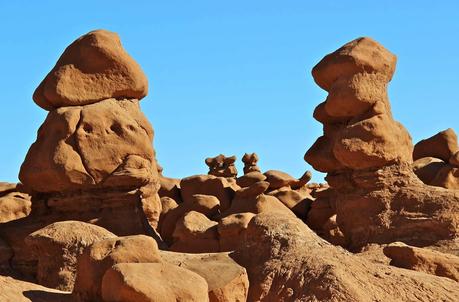
Rock goblins in the prime of life.
On Halloween I posted a day-appropriate geo-challenge. The answer is ... Goblin Valley State Park in southeast Utah. Here goblins live and die. No one has measured their lifespan precisely, but we know it’s pretty short considering they’re made of rock.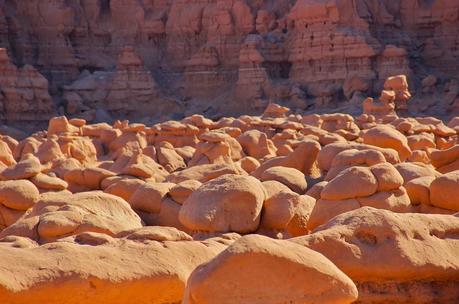
Hundreds of goblins hang out near the parking lot, one of three large goblin gatherings in the Park.
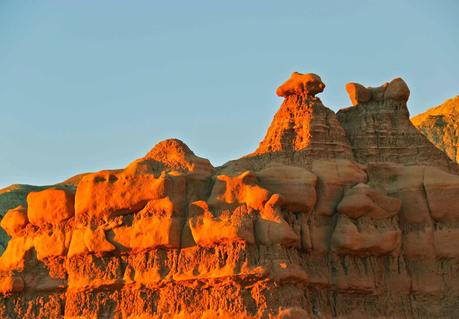
Two young sandstone-capped goblins at sunrise, near the campground. The cliff below them is a goblin nursery.
Younger goblins sport jaunty caps of sandstone that protect underlying softer rock for awhile. But erosion takes its toll. The goblins finally lose their caps and then vanish.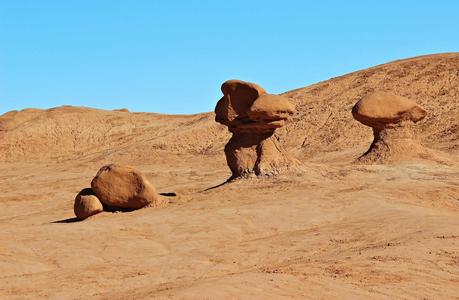
Two aging goblins on right. The one on the left has vanished, leaving only its cap.
The geological term for goblins is "hoodoo". There’s some disagreement as to what qualifies as a hoodoo. There are broad definitions:Hoodoos are tall [or not] skinny spires of rock that protrude from the bottom of arid basins and "broken" lands (National Park Service).and more narrow:
a landform consisting of a column of clay or earth capped and protected from erosion by a boulder (Collins English Dictionary)Capped hoodoos frequently are called mushroom rocks, and indeed Arthur Chaffin, who reported these hoodoos in the late 1920s, called the area Mushroom Valley. Later it was acquired by the State of Utah and became a park in 1964, changing names along the way.
Undoubtedly Chaffin was not the first to see the goblins. This is the land of the Ute people, and surely they had stories to explain the odd forms. Indeed many look like animate beings turned to stone. But it seems any such stories are lost. In contrast, geologists have written down their story so we still have it. It starts like this ...
Roughly 150-200 million years ago, a giant erg (dune field, like the Sahara) covered much of eastern Utah just south of a shallow sea. Later the dunes were buried under terrestrial and marine deposits and eventually turned to rock. Then the region was uplifted. Erosion went to work, exposing the sandstone. Weathering and erosion sculpted fantastic forms – arches, tafoni and hoodoos. In 1928 two geologists, Gilluli and Reeside, formally named and described this particular sandstone – the Entrada (Milligan 2003).
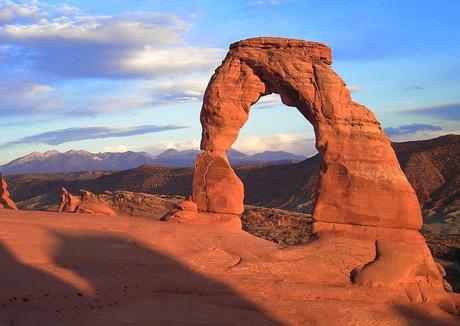
The Entrada sandstone we all know and love – at Arches National Park in Utah. Photo by Palacemusic.
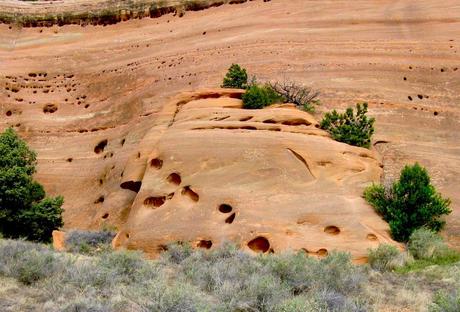
Tafoni in Entrada sandstone at McInness Canyons National Recreation Area.
The Entrada varies from place to place because the original landscape varied; it wasn’t all dunes all the time. Goblin Valley was a broad tidal flat about 170 million years ago (University of Utah no date), draining into the sea to the north. This itself was a land of change. There was the ebb and flow of tides, depositing sand and mud and then eroding it. Tidal channels shifted. Dunes came and went. The shoreline moved as sea level changed. There’s a record of all this in the rocks at Goblin Valley: large-scale cross-bedding of ancient dunes, filled-in remnants of tidal channels, fine cross-bedding indicative of ebb and flood tides, and bands of different rock types – siltstone and shale as well as sandstone (Milligan 2003). These interbedded strata are critical for hoodoo development.
Interbedded strata in the goblins also make up the wall behind, where erosion carves out new goblins.
Sandstone is harder and erodes more slowly. It can protect underlying siltstones and shales to some degree. But they still weather and erode, first becoming pedestals, then just piles after the sandstone cap falls, and finally part of the dirt around them.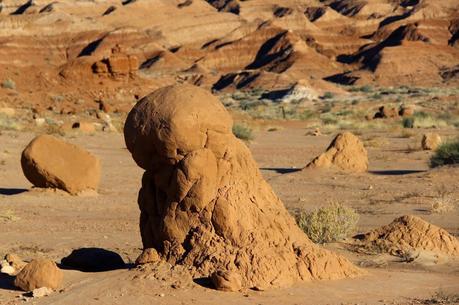
Goblin in its "golden" years. When the cap falls, the softer rock will soon disappear; note piles on right.
Goblin development depends on vertical cracks as well as horizontal layers. It's in these cracks that weathering and erosion start. Goblin Valley lies within an area where the Entrada is extensively faulted (Milligan 2003). Just north of the Park are multiple sets of vertical microfractures that form blocks on a scale similar to goblin size. It’s assumed that these occur in the Park too.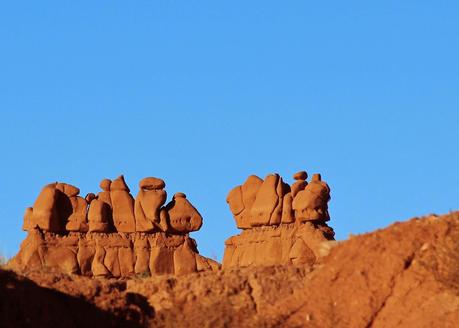
These goblins are still partly joined with their siblings. Note vertical joints.
There may be a third factor in development – the degree to which sand grains are cemented together. This might explain the oddly-shaped caps. But no one has studied cementation in the Entrada sandstone in the Park.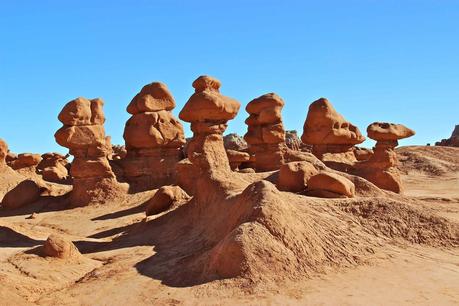
The latest in goblin headwear. Note cap-less piles in front -- dying goblins.

The cap in left mid-ground is called a turtle.
To visit the goblins, take Utah State Highway 24 southwest from Interstate 70 west of Green River, or northeast from Hanksville to the signed turnoff to Goblin Valley State Park. Milligan (2003) described it as “one of Utah’s most remote and isolated state parks” but no such luck now. It’s popular, especially in spring and fall. The goblin overlook was busy on Friday and Saturday, but after a short hike into the desert I saw no one. The small campground has nice but tightly-clustered sites (and a few yurts). For $20 you can get a tent site and shaded table, drinking water, great scenery, and a free-but-challenging hot shower under a very narrow stream of water.
Panorama by Aaron D. Gifford; source.
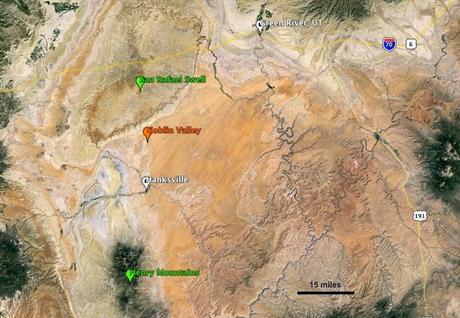
Where on Google Earth (click on image for a better view).
SourcesMilligan, MR. 2003. Geology of Goblin Valley State Park, Utah, in Anderson, PB and Sprinkel, DA, eds., Geologic road, trail and lake guides to Utah's parks and monuments. UGA Publ 29.Ornduff, RL, Wieder, RW and Futey, DG. 2006. Geology underfoot in southern Utah. Missoula, MT: Mountain Press Publishing Co.University of Utah. No date. Entrada Sandstone (in San Rafael Group). Accessed November 2014.
